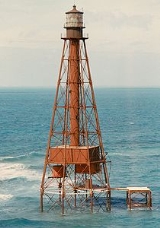
Sombrero Key Light
Encyclopedia
Sombrero Key Light is located near Key Vaca
in Marathon, Florida
. The lighthouse is located on a mostly submerged reef
. The name Sombrero Key goes back to the Spanish
, and old charts show a small island at the spot, but by the later 19th Century the island had eroded away, with some parts of the reef exposed at low tide. As a result, the reef and the lighthouse have also been called Dry Banks.
The lighthouse was put in service in 1858, automated in 1960, and is still in operation. The foundation is iron pilings with disks, and the tower is a skeletal octagonal pyramid of cast iron. It is 142 feet tall and is painted brown. It has two platforms. The lower one, 15 feet above the water, held water and fuel tanks, the generator (after the light was electrified), boat hoists and a workshop. The upper platform, 40 feet above the water, held the quarters for the staff. The original lens, a first order Fresnel lens
, is now on display in the Key West Lighthouse Museum. The Sombrero Key Light is the tallest lighthouse in the Florida Keys
, and was the last lighthouse constructed under the supervision of Lieutenant George Meade
of the Bureau of Topographical Engineers.
Key Vaca
Key Vaca is an island in the middle Florida Keys, located entirely within the borders of the city of Marathon, Florida. It is often incorrectly identified as "Marathon Key."- Geography :Key Vaca is located between Fat Deer Key and Knight's Key...
in Marathon, Florida
Marathon, Florida
Marathon is a city on Knight's Key, Boot Key, Key Vaca, Fat Deer Key, Long Point Key, Crawl Key and Grassy Key islands in the middle Florida Keys, in Monroe County, Florida, in the United States. As of the 2000 census, the city had a total population of 10,255. As of 2005, the population estimated...
. The lighthouse is located on a mostly submerged reef
Coral reef
Coral reefs are underwater structures made from calcium carbonate secreted by corals. Coral reefs are colonies of tiny living animals found in marine waters that contain few nutrients. Most coral reefs are built from stony corals, which in turn consist of polyps that cluster in groups. The polyps...
. The name Sombrero Key goes back to the Spanish
Spain
Spain , officially the Kingdom of Spain languages]] under the European Charter for Regional or Minority Languages. In each of these, Spain's official name is as follows:;;;;;;), is a country and member state of the European Union located in southwestern Europe on the Iberian Peninsula...
, and old charts show a small island at the spot, but by the later 19th Century the island had eroded away, with some parts of the reef exposed at low tide. As a result, the reef and the lighthouse have also been called Dry Banks.
The lighthouse was put in service in 1858, automated in 1960, and is still in operation. The foundation is iron pilings with disks, and the tower is a skeletal octagonal pyramid of cast iron. It is 142 feet tall and is painted brown. It has two platforms. The lower one, 15 feet above the water, held water and fuel tanks, the generator (after the light was electrified), boat hoists and a workshop. The upper platform, 40 feet above the water, held the quarters for the staff. The original lens, a first order Fresnel lens
Fresnel lens
A Fresnel lens is a type of lens originally developed by French physicist Augustin-Jean Fresnel for lighthouses.The design allows the construction of lenses of large aperture and short focal length without the mass and volume of material that would be required by a lens of conventional design...
, is now on display in the Key West Lighthouse Museum. The Sombrero Key Light is the tallest lighthouse in the Florida Keys
Florida Keys
The Florida Keys are a coral archipelago in southeast United States. They begin at the southeastern tip of the Florida peninsula, about south of Miami, and extend in a gentle arc south-southwest and then westward to Key West, the westernmost of the inhabited islands, and on to the uninhabited Dry...
, and was the last lighthouse constructed under the supervision of Lieutenant George Meade
George Meade
George Gordon Meade was a career United States Army officer and civil engineer involved in coastal construction, including several lighthouses. He fought with distinction in the Second Seminole War and Mexican-American War. During the American Civil War he served as a Union general, rising from...
of the Bureau of Topographical Engineers.

